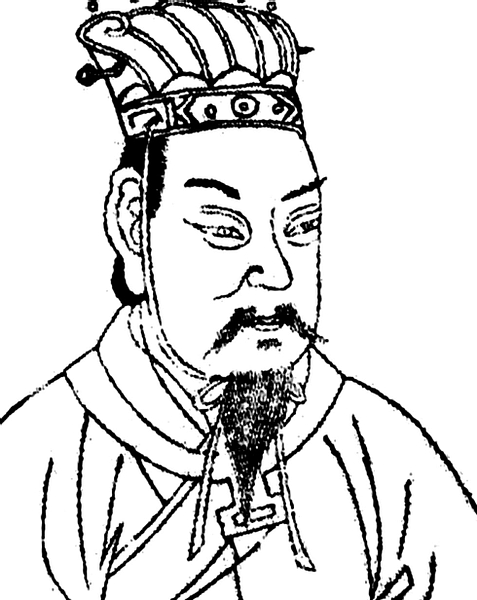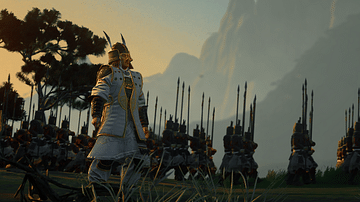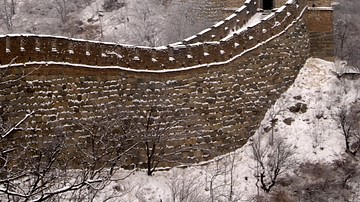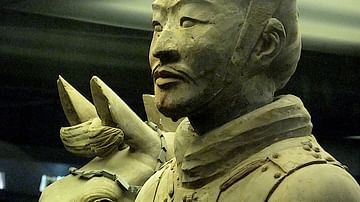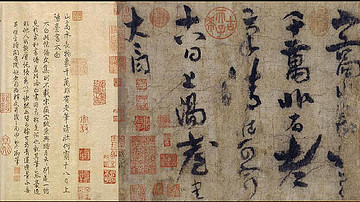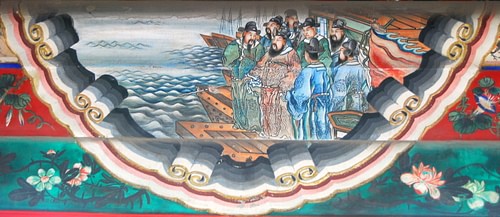
Cao Cao (c. 155-220 CE) was a military dictator in ancient China during the end of the Han dynasty. Something more than a mere warlord, Cao Cao supported a puppet emperor and governed a large area of northern China. His attempts to unify China ultimately failed, but he did found the large state of Wei and introduced various administrative changes including a new social ranking system and land reforms. Cao Cao's ruthless objective of recapturing the lost glory of the Han empire, his manipulation of the imperial court and association with unsavoury political intrigues have resulted in an ambiguous reputation which has darkened ever since his portrayal as the villain of the popular 14th-century CE epic the Romance of the Three Kingdoms.
Early Life & Family
The early life and biographical details of Cao Cao are sketchy and disputed, facts being difficult to separate from legend. Cao Cao was born in c. 155 CE, the son of Lady Ding and Cao Song, who was himself the adopted son of Cao Teng, an influential and powerful eunuch at the Han court. The association with the eunuchs, who pulled the strings of imperial politics behind the scenes, was, no doubt, one of the reasons for Cao Cao's meteoric rise. Cao Cao may also have been adopted, possibly from the Xiabou, an aristocratic family group in the Pei district, modern Boxian. Cao Cao had many children of his own, the most famous being his sons Cao Pi and Cao Zhi.
Yellow Turban Rebellion
Cao Cao's first role of note was as Commandant and police chief at Luoyang, the capital, during the 170s CE. He early-on established a reputation for being a stickler with the law and was not afraid to challenge the rich and powerful. He came to wider prominence when he famously put down the Yellow Turban rebellion in the second half of the 2nd century CE. The rebellion was so called because the protagonists wore a turban whose colour represented earth, an element they hoped would put out the fire which was the element selected by the Han. A religious movement, the Yellow Turban cult probably derived from Tibet and was closely associated with Taoism. Its popularity was helped by the promotion of aid to the poor and criticism of the discrimination against women and the lower classes, which was rife in Chinese society. The cult eventually turned into a major military rebellion, which was rather ironic considering its leader Zhang Jue preached the objective of a Great Peace.
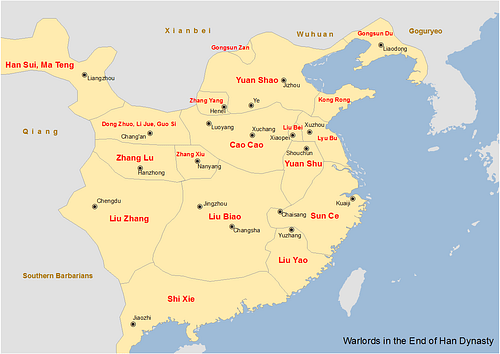
Strong in eastern China, the rebels, nevertheless, coordinated a series of uprisings across China in 184 CE which attacked the offices of local government. The whole of the country was split into pockets held by rebels, warlords, or regional governors still loyal to the state. The confusion, constant warring, and deprivation of the Chinese people were summarised in a poem attributed to Cao Cao, who, like many leaders of the period, had a serious literary bent.
My armour has been worn so long that lice breed in it,
Myriad lineages have perished.
White bones exposed in the fields,
For a thousand li not even a cock is heard.
Only one out of a hundred survives,
Thinking of it rends my entrails.
(Lewis, 28)
The rebellion was brutally quashed by an army sent by Cao Cao, and Zhang Jue was killed or executed. The movement did rumble on under new leadership in eastern Sichuan province but was finally stamped out in 215 CE, again by a Cao Cao-sent force.
An unfortunate consequence of the rebellion was that several local warlords had been backed to raise their own armies and deal with the Yellow Turbans in their area. When the rebels were dealt with, these armies often clashed with each other and there followed a sustained period of civil war during which Luoyang was sacked in 189 CE.
Cao Cao, after several setbacks, eventually established himself as the powerful governor of Yan province by 196 CE. He made his headquarters at Xu in Yingchuan (Henan province). Cao Cao would eventually become the most powerful of the Chinese warlords, particularly following his victory over rival warlord Yuan Shao at the battle of Guandu in 199-200 CE. Cao Cao took on a series of impressive titles in his role as the most powerful man at court: Marquis, Director of Retainers and then Excellency of Works. By 205 CE he was able to take the reigns of government, with the emperor left in place merely as a token gesture to past tradition. Choosing Ye as his capital, Cao Cao took many of the emperor's previous privileges for himself and adopted the titles of chengxiang or Imperial Chancellor in 208 CE and Duke of Wei in 213 CE. In 216 CE he went a step further and declared himself the King of Wei, as his state was now known. The year before the former warlord had made one of his daughters empress, completing his stranglehold on power.
Cao Cao's Reforms
Cao Cao, although having conquered the Yellow River valley, the Wuhuan in the northeast (207 CE), and now holding much of northern China, struggled to control all of the former Han territories. Large areas under the jurisdiction of rival warlords still remained. His attempts to unify a greater area of China met with spectacular failure in the form of a resounding defeat at the battle of Red Cliffs in the Yangtze Valley in 208 CE. Disease and unfamiliarity with both local geography and southern fighting techniques may have combined to frustrate Cao Cao's empire-building ambitions. The victor that day was the young warlord Sun Quan who would later become the emperor of the rival Wu state.
In order to consolidate the lands he did control, Cao Cao embarked on a series of administrative reforms which were designed to reinforce the centralisation of Chinese government and ensure the tentacles of the state were far-reaching and unchallenged. One of the features of the reforms was to curb excessive state expenditure. For this reason, there were laws passed which, for example, forbade the use of costly jade funerary shrouds.
Other measures included the introduction of a nine-level ranking system for court officials (jiupin zhongzheng), a system which lasted right through several later dynasties. This is not to say that there were any significant changes in the recruitment process, though, as Cao Cao continued the tradition of selecting ministers and officials based on who they knew, what their standing was in the local community, and where they came from rather than pure talent. Designed to exploit the official's local contacts and knowledge, the system only ended up favouring those with the right connections who could jump several steps in the nine-rung ladder of promotion.
Another policy of Cao Cao's was designed to break up traditional regional loyalties and fill up the state coffers. This involved allowing the resettlement of peasants left homeless on to abandoned lands reclaimed by the state after war had ravaged the area. The peasants and defeated rebels similarly resettled became paying tenants and thus a useful source of income for the state without the middleman of a local tax collector.
Death & Legacy
Cao Cao died in 220 CE but his second son, Cao Pi, would go on to outdo his father. Forcing the last Han emperor to abdicate, he then founded the Wei dynasty (221-265 CE). Calling himself Emperor Wen, he also became an accomplished and pioneering poet and literary critic. Cao Cao was, meanwhile, given the posthumous title of Emperor Wu of Wei, but his goal of a unified China would not be realised for another three centuries. The life of Cao Cao was recorded in his own book, Apologia, written in 210-211 CE and one of the earliest autobiographies from ancient China.
Cao Cao's life is also the subject of a celebrated novel from the Ming Dynasty (1368-1644 CE), the Romance of the Three Kingdoms (Sanguo yanyi), where he is the deliciously Machiavellian villain of the piece. Operas, too, cast him as a villain, with actors portraying the dictator usually wearing a snarling white mask with sinister eyebrows. More recently, the military leader has become the subject of several popular television series and computer games. Again indicative of the dubious reputation of the dictator, his name lives on in the Chinese expression “Speak of Cao Cao and he appears” which is broadly equivalent to “Speak of the devil” in English.
Cao Cao's Tomb
Interest in Cao Cao was further piqued in 2008 CE by Chinese archaeologists claiming they had discovered his tomb. Excavated near Xigaoxue in Henan province, the tomb consists of two main chambers connected by an arched doorway and covers 750 square metres (8,000 square feet). Unfortunately, the tomb had already been looted and its connection with Cao Cao has been difficult to ascertain with certainty. The tentative link is based on three stones inscribed with “Wu of Wei”, one discovered some distance from the tomb itself, one which may have been removed from the tomb, and a third found by archaeologists in the tomb itself and describing several bronze weapons as belonging to Wu of Wei. However, the absence of corroborating evidence, coupled with past cases of the Chinese state making similar premature claims for important historical figures, has led to archaeologists and historians outside China (and some academics inside it) to dispute the claim that it is the dictator's tomb. The tomb does seem to belong to the right place and period, and an important person was certainly interred there. Time and further study may well tell if the tomb at Xigaoxue is indeed the final resting place of Cao Cao, one of ancient China's most enigmatic figures.
